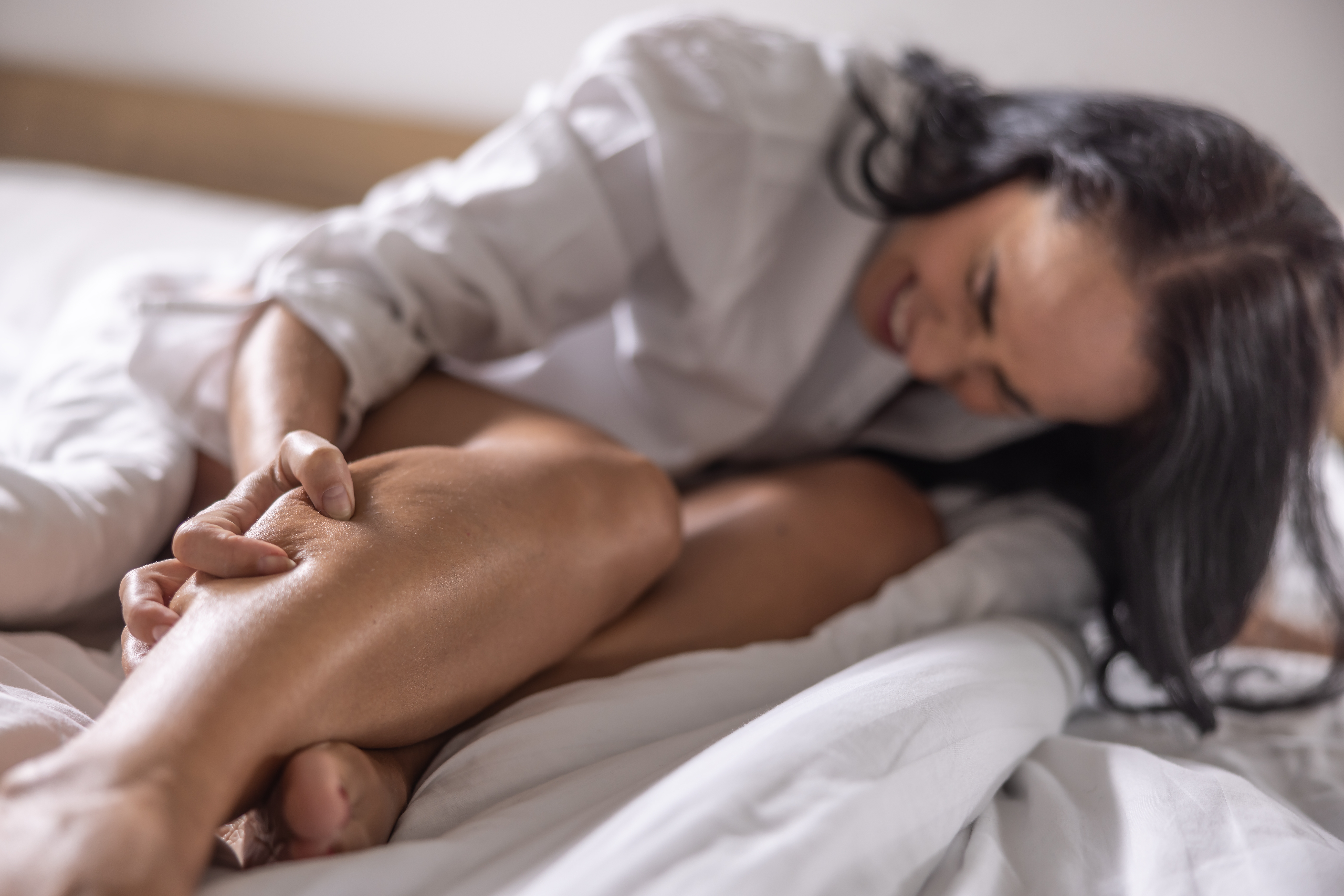Combatting Leg Cramps While Sleeping: Pillows, Mattresses, & More
There are more than a few tricks you can try if your position in bed is causing tense leg cramps while sleeping. For starters, you can use pillows to relax your feet and legs. You can also use them to prevent your toes from tensing by raising your feet. You can even consider raising your legs with a wedge pillow.
Sleeping on your side can keep your spine aligned and body relaxed with a knee pillow between your legs. Many people suffering from pain use orthopedic leg pillows to improve their sleeping experiences. Knee pillows also present themselves as a useful tool, especially for side sleepers. For those suffering from frequent night leg cramps, experts recommend sleeping on their backs with a pillow underneath their knees.
Those who sleep on their stomachs should scoot down a few inches until their feet hang off the bed. By doing this, you’ll keep your body relaxed and less likely to tense or cramp. There are times when your body or leg position may be the cause of leg cramps. In fact, calf cramps every night can be particularly problematic when you sleep with your feet pointed downwards.
Poor sleep posture is one of the underlying causes of a disturbing night’s sleep. Just as having a good sitting posture during the day is important, having a healthy sleeping posture at night is also important, helping you alleviate leg cramps and pain while sleeping.
Leg Cramps While Sleeping and the Advantages of Leg Pillows
The number of adults reporting leg cramps while sleeping across the nation is increasing. Since having your legs and hips twisted while sleeping can aggravate these cramps, you may want to consider the circulatory benefits of placing a soft pillow between your legs to keep them loose.
Without adequate support, sleeping on your side can bend or twist your spine, with joints becoming strained if you stay like that all night. A pillow between your legs helps you sleep on your side properly and enjoy:
- Increased blood circulation. Your vena cava, the central vein transporting blood to your heart, will be fully opened when you place a pillow between your legs.
- By keeping your knees stacked up, pressure is relieved. As a result, your hips and pelvis are aligned and discomfort is relieved in your lower extremities. This prevents your hip from twisting and pulling your spine out of alignment, keeping calf cramps every night at bay.
- Sleep apnea sufferers and nearly anybody else may benefit from side sleeping. Sleeping in this position stabilizes your airways and reduces the likelihood of you obstructing them. By keeping the spine aligned, you reduce the risks of sleep apnea, as well as neck and back pain.
On a side note, these options are also great for those suffering from lower back pain or leg pain, particularly sciatica. In any case, you should consult a doctor or pain management specialist for sleeping, circulatory, and pain problems. However, pillows between your legs in bed — and knee cushions between your knees — offer healthy benefits for those trying to cope every night.
How to Correctly Use a Wedge Pillow, and Why It Helps
An orthopedic wedge pillow can improve your sleep quality. Millions of patients have touted their nighttime success in beating back leg cramps while sleeping. It has a triangular shape and a tapered incline. Your upper body or legs can be lifted 6 – 12 inches, which can raise the body or legs between 30 and 45 degrees.
Here’s where a wedge pillow is particularly beneficial:
- Back sleeping and leg articulation. A wedge pillow under the knees of back-sleepers can relieve pressure on your lower back, helping muscles fully relax. Sleeping with your legs raised increases blood circulation, preventing swelling in your legs and feet (and inhibiting varicose veins from forming). Improved circulation also promotes healing and recovery for those with heart disease and other serious medical conditions.
- Side sleeping with an elevated position. A wedge pillow maintains the spine in a neutral position when side sleeping, preventing tension from building in back muscles. A memory foam wedge with a medium-firm feel will also cradle your shoulders. This prevents any pressure points and brings relief from calf cramps every night.
- Reclining in an upright position. Wedge pillows can be placed flat on a mattress if you enjoy reading in bed. If you have a headboard or wall behind your bed, the pillow’s flat side should rest against it. This pillow position allows you to recline upright without putting pressure on your neck or upper back.
- Sleeping on your back. When lying on your back, snoring and sleep apnea symptoms can worsen. Those with sleep apnea may experience breathing stops and starts because of relaxed tissue in their throats. With a wedge pillow under your upper body (and the pillow’s thinnest area resting near the middle of your back), your airway will open when reclining, making breathing easier and preventing obstructions caused by lazy-tongue.
Using the Right Mattress to Battle Leg Cramps While Sleeping
You might also experience leg cramps while sleeping if you sleep on a poor-quality mattress. A comfortable, pricier mattress is sometimes essential to a good night’s sleep for many patients, which means it’s key to fighting back cramping and pain.
Hybrid mattresses and memory foam mattresses relieve pressure and provide optimal support for your muscles and joints, especially because of their contour-adapting capabilities. These mattresses — sometimes called “cloud mattresses” — have a plush feel. Cloud mattresses vary significantly between brands. Be sure to find a guide that helps you ensure the mattress you want checks all the right boxes. Support, comfort, and cooling are all equally important before you buy a new bed, and cloud mattresses differ from other types of mattresses.
On the firmness scale, cloud mattresses retain their softness through a layered memory foam, which means latex or traditional spring mattresses are not available in the cloud mattress category. Firmer mattresses come with a lot of buoyancy, which offers a “bouncy” sensation — but there is little to no bounce in a cloud mattress. Memory foam cloud mattresses tend to perform better when it comes to comfort and support than other types of mattresses.
Several brands offer cloud mattresses. Other types of mattress foam typically can’t match the plushness of memory foam. Overall, they offer unique motion isolation, superior cooling, and quality support to give you the best night’s sleep for avoiding calf cramps every night and other lower-extremity pain.
Exercise, Footwear, Hydration, and Hot-Cold Therapy
Leg cramps while sleeping can result in aching and tightening sensations, which can lead to poor rest, affecting your overall quality of life. It’s a disorder affecting more than half of all U.S. adults at some point in their lives.
Your pain management specialist or doctor may be able to identify a cause for leg cramps based on your medical history and help you develop a treatment plan to alleviate this nighttime problem:
- Leg cramps can be prevented by exercising your legs before bed. Take a few minutes to stretch or pedal on an exercise bike. Also, sleep in loose, light, and untucked bedding. Tucked-in bedding that is heavy can put extra pressure on your legs.
- Use comfortable, supportive footwear throughout the day and drink plenty of water. Keeping your feet and legs healthy requires proper hydration and good footwear.
- Using your hands to massage the affected area can help you ease the cramp. The cramping muscle can also be relaxed by stretching and straightening your leg, as well as walking on your heels for a few minutes.
- Heat or cold therapy can also be used. Warm towels or heating pads can ease sore muscles, as can warm baths or cold ice massages.
Suffering from calf cramps every night can also be indicative of a more serious health problem. Consider consulting a pain management specialist if your cramps are unbearably painful or disruptive to your normal routine.
Wellness and Pain Can Help
A range of options for treating leg cramps while sleeping are available at Wellness and Pain. We offer conservative treatments, routine visits, and minimally invasive quick-recovery procedures. We can keep you free of problems by providing lifestyle education and home care advice to help you avoid and manage issues, quickly relieving the inhibiting lifestyle conditions when complications arise.
At Wellness and Pain, we personalize patient care plans based on each patient’s condition and unique circumstances to relieve pain, improve mobility and mental space, and improve your overall health.











